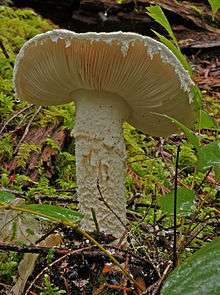Amanita smithiana
| Amanita smithiana | |
|---|---|
 | |
| Scientific classification | |
| Kingdom: | Fungi |
| Division: | Basidiomycota |
| Class: | Agaricomycetes |
| Order: | Agaricales |
| Family: | Amanitaceae |
| Genus: | Amanita |
| Species: | A. smithiana |
| Binomial name | |
| Amanita smithiana Bas (1969) | |
| Amanita smithiana | |
|---|---|
|
| |
| gills on hymenium | |
| cap is convex | |
| hymenium is free | |
| stipe has a ring and volva | |
| spore print is white | |
| ecology is mycorrhizal | |
| edibility: poisonous | |
Amanita smithiana, also known as Smith's amanita, is a species of agaric found on soil in coniferous (Abies, Tsuga, Pseudotsuga) and broadleaved (Alnus, Quercus) woodland in the Pacific Northwest of North America. It fruits in August and September.
Taxonomy
Amanita smithiana was described by Dutch mycologist Cornelis Bas in 1969. The specific epithet honors mycologist Alexander H. Smith, who collected the type specimens from Washington in 1941.[1] It belongs in the subgenus Lepidella.
Description
The cap has a diameter of 5–17 cm (2–7 in) and is white and scaled with remnants of the universal veil. The stipe is 6–18 cm (2–7 in) long by 1–3.5 cm (0.4–1.4 in) thick, white and similarly scaled, with a ring.[2] Spores are ellipsoid to elongated, amyloid, and measure 11–12.5 by 7–8 µm.[1]
Toxicity
It is responsible for poisonings in the Pacific Northwest when mistaken for the edible and sought after Tricholoma magnivelare. It causes initial gastrointestinal symptoms that manifest 1 to 12 hours after eating the mushrooms,[3] followed by acute renal failure after a delay of 2–6 days. This is often severe, requiring hemodialysis, but most patients recover normal kidney function within several weeks.[4] Gastroenteritis may result in a large loss of fluid volume. Amanita smithiana nephrotoxicity is from chlorocrotylglycine and allenic norleucine.[3]
Several similar species have been implicated in similar cases of acute renal failure: A. sphaerobulbosa, A. thiersii, A. proxima, (Spain) and A. pseudoporphyria (Japan).[2]
See also
References
- 1 2 Bas C. (1969). "Morphology and subdivision of Amanita and a monograph of its section Lepidella". Persoonia. 5 (3): 285–579 (see p. 418).
- 1 2 Tulloss RE. "Amanita smithiana". Amanitaceae.org. Retrieved 2014-05-06.
- 1 2 Greenberg, Michael I. (2005). Greenberg's Text-atlas of Emergency Medicine. Lippincott Williams & Wilkins. p. 854. ISBN 978-0-7817-4586-4.
- ↑ Saviuc P, Danel V. (2006). "New Syndromes in Mushroom Poisoning". Toxicological Reviews. 25 (3): 199–209. doi:10.2165/00139709-200625030-00004. PMID 17192123.